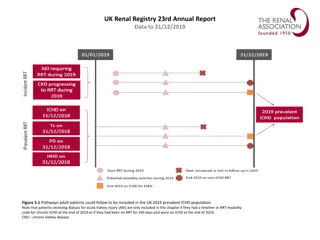
Understanding Database Normalization Process
Database normalization is a crucial process in database development where anomalies in relations are systematically examined and corrected. It involves splitting relations to create a more structured and efficient database design. Discover the benefits of normalization, its importance in reducing data redundancy, and how it facilitates data integration and maintenance. Learn about the potential problems that can arise without proper normalization, such as insertion, updating, and deletion anomalies.
Download Presentation

Please find below an Image/Link to download the presentation.
The content on the website is provided AS IS for your information and personal use only. It may not be sold, licensed, or shared on other websites without obtaining consent from the author. If you encounter any issues during the download, it is possible that the publisher has removed the file from their server.
You are allowed to download the files provided on this website for personal or commercial use, subject to the condition that they are used lawfully. All files are the property of their respective owners.
The content on the website is provided AS IS for your information and personal use only. It may not be sold, licensed, or shared on other websites without obtaining consent from the author.
E N D
Presentation Transcript
is a process in which we systematically examine relations for anomalies and, when detected, remove those anomalies by splitting up the relation into two new, related, relations. is an important part of the database development process: normalization, the database designers get their first real look into how the data are going to interact in the database. Often during
Finding problems with the database structure at this stage is strongly preferred to finding problems further along in the development process because at this point it is fairly easy to cycle back to the conceptual model (Entity Relationship model) and make changes.
Normalization can also be thought of as a trade-off between data redundancy and performance. Normalizing redundancy but introduces the need for joins when all of the data is required by an application such as a report query. a relation reduces data
A relationis a set of attributes with values for each attribute such that: 1. Each attribute (column) value must be a single value only. 2. All values for a given attribute (column ) must be of the same data type. 3. Each attribute (column) name must be unique. 4. The order of attributes (columns) is insignificant 5. No two tuples (rows) in a relation can be identical. 6. The order of the tuples (rows) is insignificant.
Normalization Benefits: 1. Facilitates data integration. 2. Reduces data redundancy. 3. Provides a robust architecture for retrieving and maintaining data. 4. Compliments data modeling. 5. Reduces the chances of data anomalies occurring.
2. Problem Without Normalization Without Normalization, it becomes difficult to handle and update the database, without facing data loss. Insertion, Updating and Deletion Anomalies are very frequent if Database is not Normalized. To understand these anomalies let us take an example of Student table.
S_id S_Name S_Address Subject_opted 401 Adam Noida Bio 402 Alex Panipat Maths 403 Stuart Jammu Maths 404 Adam Noida Physics
Updating Anomaly : To update address of a student who occurs twice or more than twice in a table, we will have to update S_Address column in all the rows, else data will become inconsistent.
S_id S_Name S_Address Subject_opted 401 Adam Noida Bio 402 Alex Panipat Maths 403 Stuart Jammu Maths 404 Adam Noida Physics
Insertion Anomaly : Suppose for a new admission, we have a Student id(S_id), name and address of a student but if student has not opted for any subjects yet then we have to insert NULL there, leading to Insertion Anamoly.
S_id S_Name S_Address Subject_opted 401 Adam Noida Bio 402 Alex Panipat Maths 403 Stuart Jammu Maths 404 Adam Noida Physics
Deletion Anomaly : If (S_id) 401 has only one subject and temporarily he drops it, when we delete that row, entire student record will be deleted along with it.
S_id S_Name S_Address Subject_opted 401 Adam Noida Bio 402 Alex Panipat Maths 403 Stuart Jammu Maths 404 Adam Noida Physics
3 Functional Dependencies The single most important concept in relational schema design theory . . is a constraint between two sets of attributes from the database. ( . A functional dependency is a property of the semantics or meaning of the attributes. .
Suppose that our relational database schema has n attributes A1, A2, ..., An. If we think of the whole database as being described by a single universal relation schema R = {A1, A2, ... , An} A functional dependency, denoted by X Y, between two sets of attributes X and Y that are subsets of R, such that any two tuples t1 and t2 in r that have t1[X] = t2[X], they must also have t1[Y] = t2[Y].
This means that the values of the Y component of a tuple in r depend on, or are determined by, the values of the X component; We say that the values of the X component of a tuple uniquely (or functionally) determine the values of the Y component. We say that there is a functional dependency from X to Y, or that Y is functionally dependent on X. X is functionally determines Y Y is functionally dependent on X
Functional dependency is represented as FD or f.d. The set of attributes X is called the left-hand side of the FD, and Y is called the right-hand side. X:left hand side of FD, Y :Right hand side of FD X functionally determines Y in a relation schema R if, and only if, whenever two tuples of r(R) agree on their X-value, they must necessarily agree on their Y-value.
If a constraint on R states that there cannot be more than one tuple with a given X-value in any relation instance r (R) that is, X is a candidate key of R this implies that X Yfor any subset of attributes Y of R. If X is a candidate key of R, then X R. If X Y in R, this does not imply that Y X in R.
A B C D a1 b1 c1 d1 a1 b2 c2 d2 a2 b2 c2 d3 a3 b3 c4 d3 The following FDs may hold because the four tuples in the current extension have no violation of these constraints: B C; C B; {A, B} C; {A, B} D; and {C, D} B However, the following do not hold because we already have violations of them in the given extension: A B (tuples 1 and 2 violate this constraint); B A (tuples 2 and 3 violate this constraint); D C (tuples 3 and 4 violate it).
3.1 Fully Functional Dependency (composite key) If attribute B is functionally dependent on a composite key A but not on any subset of that composite key, the attribute B is fully functionally dependent on A. Employee ( Emp-no , Emp-name, Bdate, Dept-no, Dept-name) Emp-no , Dept-no Dept-name
3.2 Partial Dependency When there is a functional dependence in which the determinant is only part of the primary key, then there is a partial dependency. For example if (A, B) (C, D) and B C and (A, B) is the primary key, then the functional dependence B C is a partial dependency. Employee ( Emp-no , Emp-name, Bdate, Dept-no, Dept-name) Emp-no Emp-name, Bdate
3.3 Transitive Dependency When there are the following functional dependencies such that X Y, Y Z and X is the primary key, then X Z is a transitive dependency because X determines the value of Z via Y. Whenever a functional dependency is detected amongst nonprime, there is a transitive dependency.
3.3 Transitive Dependency Suppliers ( S-no , S-name , City , Transport cost ) Suppliers S-no S-name City Transport cost S1 S2 S3 S4 Amar Yasseen Amin omer PS GD GD PS 500 400 400 500 S-no City Transport cost City S-no Transport cost
3.3 Transitive Dependency The advantage of removing transitive dependency is, 1. Amount of data duplication is reduced. 2. Data integrity achieved.
4. Normalization of Relations The normalization process, as first proposed by Codd (1972a),takes a relation schema through a series of tests to certify whether it satisfies a certain normal form. The process, which proceeds in a top-down fashion by evaluating each relation against the criteria for normal forms and decomposing relations as necessary, can thus be considered as relational design by analysis.Codd proposed three normal forms, which he called first, second, and third normal form.
4.1 How do you divide your tables? The basic rule is that each table should describe one type of things, each row in the table should contain about one such thing, and the data we stored for each thing should exist in only one row.
4.2 The First Normal Form ( 1NF ) A database is in first normal form if it satisfies the following conditions: 1. All the key attributes are defined. 2. There are no repeating groups in the table. 3. The value of record must be atomic. 4. All attributes are dependent on the primary key.
stud STU-ID L-NAME F-NAME 001 Smith John 002 Smith Susan 003 Beal Fred 004 Thomoson Marie 005 Tom Jake 002 Smith Susan 004 Thomoson Marie 003 Beal Fred
Stud1 STU-ID L-NAME F-NAME 001 Smith John 002 Smith Susan 003 Beal Fred 004 Thomoson Marie 005 Tom Jake
Student STU-ID CNAME GRADE 001 English , Italian A 002 German , English B 003 Italian C Student1 STU-ID CNAME GRADE 001 English A 001 Italian A 002 German B 002 English B 003 Italian C
Employee ( E# , Ename, Dependants ) E# EName Dependant Ali E1 .. .. D# Dname Dage D1 D2 omer amna 15 14 .. E6 D# Dname Dage Osman D1 D2 amer amar 5 6
: 1NF Employee E# E1 E1 E6 E6 Ename D# D1 D2 D1 D2 Dname omer amna amer Amar Dage 15 14 5 4 Ali Ali osman osman E# , D# INF















